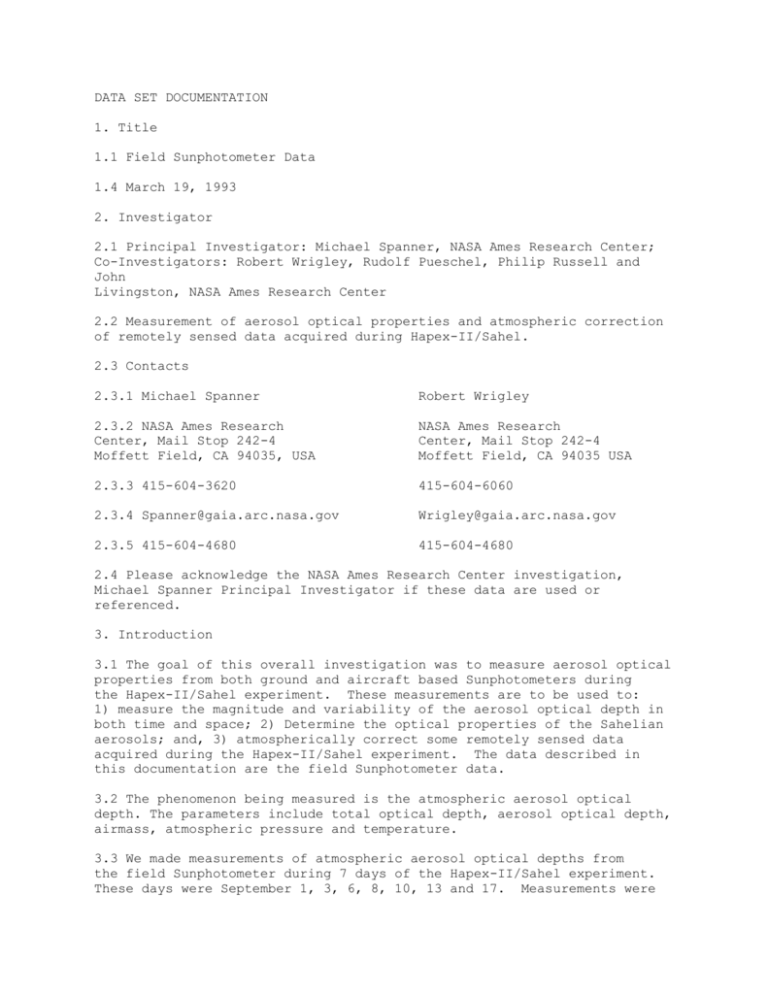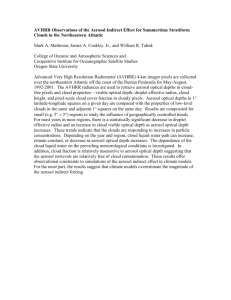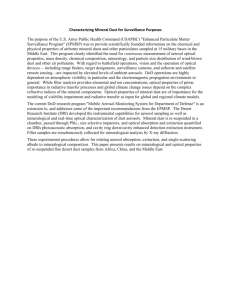DATA SET DOCUMENTATION Title 1.1. Field Sunphotometer Data
advertisement

DATA SET DOCUMENTATION 1. Title 1.1 Field Sunphotometer Data 1.4 March 19, 1993 2. Investigator 2.1 Principal Investigator: Michael Spanner, NASA Ames Research Center; Co-Investigators: Robert Wrigley, Rudolf Pueschel, Philip Russell and John Livingston, NASA Ames Research Center 2.2 Measurement of aerosol optical properties and atmospheric correction of remotely sensed data acquired during Hapex-II/Sahel. 2.3 Contacts 2.3.1 Michael Spanner Robert Wrigley 2.3.2 NASA Ames Research Center, Mail Stop 242-4 Moffett Field, CA 94035, USA NASA Ames Research Center, Mail Stop 242-4 Moffett Field, CA 94035 USA 2.3.3 415-604-3620 415-604-6060 2.3.4 Spanner@gaia.arc.nasa.gov Wrigley@gaia.arc.nasa.gov 2.3.5 415-604-4680 415-604-4680 2.4 Please acknowledge the NASA Ames Research Center investigation, Michael Spanner Principal Investigator if these data are used or referenced. 3. Introduction 3.1 The goal of this overall investigation was to measure aerosol optical properties from both ground and aircraft based Sunphotometers during the Hapex-II/Sahel experiment. These measurements are to be used to: 1) measure the magnitude and variability of the aerosol optical depth in both time and space; 2) Determine the optical properties of the Sahelian aerosols; and, 3) atmospherically correct some remotely sensed data acquired during the Hapex-II/Sahel experiment. The data described in this documentation are the field Sunphotometer data. 3.2 The phenomenon being measured is the atmospheric aerosol optical depth. The parameters include total optical depth, aerosol optical depth, airmass, atmospheric pressure and temperature. 3.3 We made measurements of atmospheric aerosol optical depths from the field Sunphotometer during 7 days of the Hapex-II/Sahel experiment. These days were September 1, 3, 6, 8, 10, 13 and 17. Measurements were made throughout the day during periods when cloudiness was at a minimum. We acquired data approximately every five minutes. These data were collected to coincide as well as possible with aircraft and satellite remote sensing measurements, in particular the NS001 TMS, ASAS and SPOT. The overall quality of the data appear to be excellent. The instrument was well calibrated both before and after the experiment at Mauna Loa Observatory, Hawaii. The field Sunphotometer data will be used in conjunction with the Airborne Tracking Sunphotometer to determine the magnitude and variability of the aerosol optical depth in both time and space. From the aerosol optical depth, we will invert the data using an algorithm developed by King et al., 1978, to derive the size distribution of the Sahelian aerosols. We will then use Mie theory to calculate the aerosol phase function and single scattering albedo. Finally, we will use the atmospheric correction algorithm of Wrigley et al., 1992 to atmospherically correct selected NS001 TMS, ASAS and SPOT data collected during the Hapex-II/Sahel experiment. Atmospheric correction of SPOT data will utilize the aerosol properties derived from surface optical depth measurements. Atmospheric correction of NS001 and ASAS data will utilize aerosol properties derived from the airborne optical depth measurements as well as those from the surface measurements. 4. Theory of Measurements: The instrument measures direct beam solar radiation in 10 channels in the visible and near infrared wavelengths. The solar radiation data are collected in the form of voltages. The instrument was calibrated both before and after the experiment at the Mauna Loa Observatory, Hawaii using the Langley plot technique. For calibration, data are collected at a number of solar angles from low solar elevation (air mass=5) to high solar elevation angle (airmass = 1.8). A regression is developed between log voltage and airmass. This regression equation is then extrapolated to an airmass of 0. This value at zero is called the zero airmass intercept voltage, and is the value that is used for calibration of the instrument. The voltages measured by the instrument during Hapex-II/Sahel were converted to total optical depth using the zero airmass intercept voltages calculated during the calibrations. The Rayleigh optical depth is subtracted from the total optical depth. Rayleigh optical depth is calculated using pressure and temperature measured at the field site. Finally NO2 and Ozone optical depth are subracted from the total minus Rayleigh optical depth. NO2 abundance was obtained from climate tables based on Noxon, 1979, and convolved with absorption coefficients at the field Sunphotometer wavelengths. Ozone optical depth was calculated using ozone abundances from the TOMS satellite instrument convolved with absorption coefficients at field Sunphotometer wavelengths. The result of this processing is the aerosol optical depth measured in 9 channels (not including the 940 nm water vapor channel) at approximately 5 minute intervals. 5. Equipment 5.1 The instrument consists of a 10 channel filter wheel Sunphotometer with a heater, an amplifier to measure voltages, a 12 volt power supply and a tripod. 5.1.1 The instrument is mounted on a tripod on the ground. 5.1.2 The mission was undertaken to measure the aerosol optical depths at the Hapex-II/Sahel field sites for the overall purpose of atmospheric correction of remotely sensed data. 5.1.3 The primary quantity being measured is aerosol optical depth. 5.1.4 The instrument measures energy in the direct beam of the Sun. From the calibrations developed before and after the experiment, these voltages are converted to aerosol optical depth, which is a measure of the extinction of the direct Solar beam by aerosols and particulates in the atmosphere. 5.1.5 The Field Sunphotometer has a 2.0 degree field of view and is heated to 40 degrees C to maintain temperature stability. It has a filter wheel design with 10 filters. The nominal wavelengths and the full width half maximum (FWHM) for the instrument are presented in the following table. Wavelength nm FWHM nm 371.5 400 440 520 610 670 780 867 938 1029 10 10 10 12 11 10 10 10 11 10 The data are recorded manually from a LCD display on the external instrument amplifier. 5.1.6 Manufactured by Dr. John Reagan, Department of Electrical and Computer Engineering, University of Arizona, Tucson, Arizona, 602-6216203. 5.2 Calibration 5.2.1 Factors which may affect calibration are instrument variations that may occur between calibrations. We have not noticed any significant drifts in calibration during the time period of the experiment. 5.2.1.1 We believe that the aerosol optical depths are accurate to a value of .01 in aerosol optical depth. 5.2.2 The instrument was calibrated at Mauna Loa Observatory, Hawaii on July 10-15 and October 27 to November 5, 1992. 5.2.3 The following table shows the calibration coefficients, corrected for Earth-Sun distance, calculated during calibration at Mauna Loa Observatory, Hawaii, on July 10-15, October 27 to November 5, and the mean values used for the Hapex-II/Sahel experiment in August and September, 1992. Wavelength nm July 10-15 October 27November 5 Mean for Experiment 371.5 400 440 520 610 670 780 867 1029 49.622 280.957 711.623 1506.656 1691.857 1708.381 1778.811 1476.614 962.177 48.588 289.219 706.755 1508.178 1742.386 1762.495 1836.128 1519.870 980.237 49.105 285.088 709.188 1507.417 1717.122 1735.438 1807.470 1498.242 971.207 6. Procedure 6.1 Data are collected manually with the field Sunphotometer. The instrument is pointed at the Sun using the Solar image in the cross hairs. As the filter wheel is turned through each of the ten channels, the beginning time, instrument temperature, voltages and gain, and finally the ending time are recorded. This sequence takes approximately one minute. This process is repeated approximately every 5 minutes for the course of the data collection period, typically from 2-6 hours. 6.2 Spatial Characteristics 6.2.1 The field of view of the instrument is 2 degrees. The Sunphotometer measures the direct beam of solar radiation. 6.2.2 See #6.2.1 above 6.3 Temporal Characteristics 6.3.1 Data were acquired during 7 days of the Intensive Observation Period. The days, times and locations were: Date September September September September September September September September 1, 1992 3, 1992 6, 1992 8, 1992 10, 1992 13, 1992 17, 1992 17, 1992 Time (GMT) Site 06:53-09:41 13:17-17:04 10:38-14:42 13:14-16:06 08:30-10:30 10:14-15:46 08:10-10:31 12:54-15:31 WCS-fal WCS-fal WCS-fal WCS-fal WCS-fal WCS-fal SS-fal SS-tig. 6.3.2 Data were acquired approximately every 5 minutes during the data acquisition periods. 7. Observations 8. Data Description 8.2 Type of data 8.2.1 8.2.2 8.2.3 8.2.4 Variable Source Description Range Units Date Day/Month/ Year September 1-17, 1992 N/A N/A Time Hours Minutes. Seconds 0-2400 GMT Watch Site Super Site, WCS-fal, SS-fal, SS-corn N/A H2SIS Instrument Reagan1, Reagan2 N/A N/A N/A Solar zenith algorithm N/A 7-78 degrees Degrees Solar Airmass N/A 1-4.5 Dimension less Solar Rayleigh N/A Reagan Tau (371.5 nm) algorithm .4836-4863 Dimension Rayleigh Reagan .3495-.3514 algorithm N/A less Dimension 8.2.5 Tau (400 nm) algorithm less Rayleigh Reagan Tau (440 nm) algorithm N/A Rayleigh Reagan Tau (520 nm) algorithm N/A. Rayleigh Reagan Tau (610 nm) algorithm N/A Rayleigh Reagan Tau (670 nm) algorithm N/A Rayleigh Reagan Tau (780 nm) algorithm N/A Rayleigh Reagan Tau (867 nm) algorithm N/A Rayleigh Reagan Tau (938 nm) algorithm N/A .2356-.2369 Dimension less 1187-.1193 Dimension less .0619-.0622 Dimension less .0423-.0425 Dimension less .0229-.0230 Dimension less .0147-.0148 Dimension less .0108 Dimension less Rayleigh N/A Reagan Tau (1029 nm) algorithm .0075 Aerosol N/A Reagan Tau (371.5 nm) algorithm .2249-.7654 Aerosol Reagan Tau (400 nm) algorithm .2172-.7852 N/A Dimension less Dimension less Dimension less Aerosol Reagan Tau (440 nm) algorithm N/A Aerosol Reagan Tau (520 nm) algorithm N/A Aerosol Reagan Tau (610 nm) algorithm N/A Aerosol Reagan Tau (670 nm) algorithm N/A Aerosol Reagan Tau (780 nm) algorithm N/A Aerosol Reagan Tau (867 nm) algorithm N/A Aerosol Tau (938 nm) N/A .2323-.7993 Dimension less .2259-.7924 Dimension less .2137-7883 Dimension less .2096-.7957 Dimension less .2036-.8146 Dimension less .1855-.8018 Dimension less Aerosol N/A Reagan Tau (1029 nm) algorithm Not Calculated N/A .1607-.7656 Dimension N/A less 8.3 Example of data entry: There are 2 records of header information followed by 1 blank record in the data file provided to Hapex-II/Sahel Information System. 01/09/92 653.00 WCS-fal Reagan1 72.8521 3.3453 0.4855 0.3508 0.2365 0.1191 0.0622 0.0230 0.0148 0.0108 0.0075 0.3829 0.3580 0.3509 0.3338 0.3145 0.3072 0.2970 0.2780 1.0057 0.2418 9. Data Manipulations 9.1 Formulas for processing data can be found in Spanner et al., 1990. 9.1.1 Description of algorithms can be found in 9.1. 9.2 Data Processing Sequence 9.2.1 The steps for processing are as follows: 1) Input data into computer, 2) Run program developed by John Reagan's lab called Pdata7 to format data, 3) Run program Atten7 to calculate all the variables including solar zenith angle, airmass, Rayleigh Optical depth and Instantaneous optical depth (Total optical depth minus Rayleigh optical depth), 4) calculate NO2 and ozone optical depths from Noxon et al., 1979 and TOMS data, respectively, 5) subtact NO2 and ozone to derive aerosol optical depth. The ozone abundance used to calculate ozone optical depth was 286 Dobson units, as determined from the TOMS satellite instrument. The following table shows the values calculated for NO2 and ozone optical depth which were subtracted from the Instantaneous optical depth to derive the aerosol optical depth. Wavelength NO2 Tau Ozone Tau 371.5 400 440 520 610 670 780 867 938 1029 0.0025 0.0028 0.0025 0.008 0.0001 0.0 0.0 0.0 0.0 0.0 0.0 0.0 0.0009 0.0129 0.0343 0.0114 0.0003 0.0 0.0 0.0 9.2.2 The processing sequence has not changed over time 9.2.3 No special corrections or adjustments have been made 10. Errors 10.1 Calibration errors would be the main source of error in the derivation of aerosol optical depth. 10.2 Quality Assessment 10.2.1 Data were compared with Airborne Tracking Sunphotometer and with data collected by R. Halthore of the GSFC ASAS Investigation (C. Walthall, P.I.). 10.2.2 Overall, we feel that these data are of high quality. Two good calibrations of the instrument were performed before and after the HapexII/Sahel field collection effort. The aerosol optical depths are accurate to a value of approximately 0.01. 10.2.3 Quantitative error estimates were not performed 11. Notes 11.1 The aerosol optical depth at 938 nm was not calculated because this channel primarily measures absorption due to water vapor. We intend to calibrate the 938 channel in the future, but at this time, the channel is not calibrated and therefore, the water vapor overburdens were not calculated for the 938 channel. The values listed in the 938 channel should be ignored. 11.2 The values of aerosol optical depth are accurate instantaneous values of aerosol optical depth. These data were taken every 5 minutes, therefore, under conditions of rapid variability in cloudiness or haze, the data may not be internally consistent or appropriate. It is useful to calculate averages of aerosol optical depth over periods of time, for example one-half hour, to get a more accurate measure of the average conditions at a site. 12. References 12.1 Portable Radiometer Data Reduction Manual for use with PDATA7 and ATTEN7, Ian C. Scott-Fleming, Department of Electrical and Computer Engineering, University of Arizona, Remote Atmospheric Sensing Lab, Tucson, Arizona, 85721, Contact: Dr. John Reagan 602-6216203. 12.2 Wrigley, R.C., M.A. Spanner, R.E. Slye, R.F. Pueschel and H.R. Aggarwal, 1992, Atmospheric Correction of Remotely Sensed Image Data by a Simplified Model, Journal of Geophysical Research, 97(D17):1879718814. Bruegge, C.J., R.N. Halthore, B. Markham, M. Spanner and R. Wrigley, 1992, Aerosol Optical Depth Retrievals Over the Konza Prairie, Journal of Geophysical Research, 97(D17):18743-18758. Spanner, M., R. Wrigley, R. Pueschel, J. Livingston and D. Colburn, 1990, Determination of atmospheric optical properties for the First ISLSCP Field Experiment (FIFE), Journal of Spacecraft and Rockets, 27:373-379. Noxon, J., 1979, Stratospheric NO2, 2, Global behavior, J. Geophys. Res., 84:5067-5076. King, M., D. Bryne, B. Herman, and J. Reagan, 1978, Aerosol size distributions obtained by inversion of spectral optical depth measurements, J. Atmos. Sci., 35:2153-2167.







